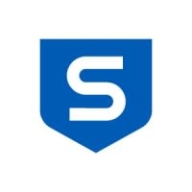


Check Point CloudGuard Network Security and Sophos XG compete in network security. Check Point CloudGuard appears to have the upper hand in cloud integration and adaptability, while Sophos XG is stronger in user-based controls and ease of on-premises deployment.
Features: Check Point CloudGuard offers comprehensive cloud support, integrated security features, and advanced threat prevention, making it adaptable across various cloud platforms. Sophos XG provides strong web protection, detailed user management, and user-based controls suitable for organizations focused on content filtering and user prioritization. It also integrates easily with existing systems.
Room for Improvement: Check Point CloudGuard needs a more user-friendly interface and better integration with third-party tools for seamless operations. Simplifying usage for new and seasoned users is also needed. Sophos XG should enhance its technical support and scalability for larger environments, while also improving the depth of its features and responsiveness in service.
Ease of Deployment and Customer Service: Check Point CloudGuard is ideal for diverse cloud environments and multi-cloud infrastructures, receiving positive feedback for its hybrid cloud support. However, improvements in technical support responsiveness are noted. Sophos XG is favored for on-premises deployments with its easy-to-manage interfaces and generally competitive customer service, though it struggles with supporting expansive cloud or hybrid environments.
Pricing and ROI: Check Point CloudGuard is known for its comprehensive security features, albeit at a higher cost, which some justify with customer-based pricing flexibility and ROI through reduced management workload. Sophos XG offers competitive pricing advantageous for small to medium businesses, delivering a solid return with simple licensing and integration, appealing to budget-conscious organizations prioritizing on-prem solutions.
Clients are now comfortable and not wasting productive hours on IT support.
We have experienced a positive return on investment by utilizing Fortinet's products.
There's definitely an ROI. Having a centralized way of managing and applying policies across the entire organization always helps.
The value lies in maintaining operational integrity with zero downtime or incidents, facilitating secure, ongoing business operations.
Implementing CloudGuard has resulted in an excellent return on investment over one hundred percent ROI.
The unified policy is comprehensive and helps me to create firewall policies that are shared across all our facilities and plants.
It's good, but I would still say it's higher by about 10-15 percent compared to other market products with similar configurations.
Having a Unified Threat Management system like Sophos XG has helped us spend less on network security, thus providing a good return on investment by managing our income effectively.
My customers see a return on investment and value for money with Sophos XG.
He explained that it required a command line configuration, as it couldn't be done through the graphical user interface.
I would rate their support for FortiGate a nine out of ten.
They offer very accurate solutions.
They usually respond quite fast, and they are very knowledgeable about what they do.
We had an endless loop of emails trying to fix this, and the suggestion was to reinstall the gateway and do it from scratch, which was not an option at that point because it would leave that specific location without access.
Available twenty-four by seven.
Users are reluctant to open support cases and would rather reinstall an appliance themselves than go through the support process.
I would rate the technical support a nine out of ten.
Microsoft's protection has received positive feedback and strong on-site support from both customers and partners.
They scale up really well from smaller models like the FortiGate 40 and 50 to bigger sites with the FortiGate 100 for more throughput - up to enterprise datacenters.
The variation comes in terms of the interfaces and throughputs, but from a security perspective, you get the same benefit, irrespective of whether you have an entry-level unit or an enterprise.
You can choose a cheaper model if you only have 20-30 users, but you will need to spend more money for a FortiGate solution that covers 5,000.
I can deploy it everywhere I need it.
We have transitioned from 1,000 to 500 users without any issue.
We perform minor and major upgrades, and it works seamlessly.
You can scale up to multiple firewalls with centralized management.
You can't upgrade memory or storage on a specific model, which limits scalability.
The scalability of the solution is limited to three nodes and may not be sufficient for extensive scaling.
Improper handling of these can lead to a memory surge, a well-known bug that can cause the entire system to freeze.
It is less stable than Palo Alto Networks and Check Point firewalls because there are lots of bugs in the latest firmware.
We have not had any problems with the operating systems or maintenance of subscriptions.
I have not observed any downtime.
For instance, when we are working on a release and do an upgrade, we start experiencing unexpected issues.
The solution is stable.
I would rate the stability of Sophos XG a ten out of ten.
Sophos XG is very stable, even when serving as a DHCP server.
Sophos XG is resource-greedy, affecting performance even on newer computers.
If I have put 10 GBPS of throughput on a firewall and I enable all of these features available, such as IPS or UTM functionalities, the throughput comes down to 1 GBPS.
By providing an integrated solution, users would have access to all features and functionalities within a single window, eliminating the need to navigate through multiple windows.
Investing in a solution that can accommodate such growth would be more cost-effective than repeatedly purchasing new hardware.
Scalability could be improved as well; needing to purchase a new license each time I want to add a new interface is not ideal.
Better documentation would be welcome.
The user interface could be more intuitive, and the initial setup and configuration can be complex, requiring a technical team.
The solution should have the ability to be up to date with the most recent threats.
This suggests a vulnerability that needs addressing to ensure administrators can update patches without losing access.
Business cannot stop just because of issues with support.
Secure SD-WAN is free of charge.
The most expensive part is the renewal of the license subscription.
FortiGate is priced lower than Palo Alto.
The pricing and licensing are expensive, costing between seven thousand to eight thousand dollars.
Check Point is expensive, however, with the features and capabilities, I can justify the cost.
It is the highest in the market.
I would rate the pricing a ten out of ten as high.
The licensing cost in the final currency amount, is 163,080, with three years of support.
I rate the pricing a ten out of ten.
The firewall, IPS, and VPN functions are the most valuable features.
FortiGate provides solid protection against viruses, malware, and other threats.
Within the same dashboard, you get to see the security profiles, the type of traffic that's passing through, the top applications that are being consumed, etc.
One of the most valuable features is the automated threat prevention, which helps us detect and block potential cyberattacks in real-time, minimizing data breaches.
Centralized management is the feature I like best, resulting in reduced workload and more continuous policy.
Network Security provides us with unified security management across hybrid and cloud as well as on-prem.
This unique technology provides efficient branch connectivity without the need to invest in additional firewalls for each branch.
I particularly like the visibility it provides into network traffic, allowing us to identify and address issues efficiently.
The firewall feature of Sophos XG has been the most effective for threat prevention.



Fortinet FortiGate offers comprehensive network security and firewall protection across multiple locations. It effectively manages data traffic and secures environments with features like VPN, intrusion prevention, and UTM controls.
Organizations rely on Fortinet FortiGate for its robust integration with advanced security policies, ensuring significant protection for enterprises, cloud environments, and educational sectors. It facilitates network segmentation, application-level security, and authentication management, securing communication within and between locations such as branches and data centers. Its efficient SD-WAN and UTM features enable streamlined data management and enhanced threat protection capabilities. Users appreciate its centralized management, facilitating seamless operations across diverse environments.
What are the key features of Fortinet FortiGate?
What benefits should users expect from Fortinet FortiGate?
Fortinet FortiGate is crucial in sectors like education, offering robust networks for secure data flow between campuses and facilitating remote learning. In enterprise environments, it allows efficient management of application traffic and security across multiple branches, while in the cloud, it seamlessly integrates with diverse platforms to enhance security infrastructure.
Check Point CloudGuard Network Security is designed to secure cloud assets, offering robust firewall capabilities and protection for both internal and external traffic across AWS, Azure, and on-premises environments.
Enterprises rely on Check Point CloudGuard Network Security for comprehensive network protection, threat prevention, and compliance enforcement. Supporting virtual machines and hybrid environments, it delivers advanced security measures including intrusion prevention and application control. Key functions include firewall security, network segmentation, and cloud environment protection, ensuring businesses maintain a secure and compliant IT infrastructure.
What are the most valuable features of Check Point CloudGuard Network Security?In industries such as financial services, healthcare, retail, and education, Check Point CloudGuard Network Security is implemented to safeguard sensitive data, ensure compliance, and protect critical infrastructure. Companies in these sectors benefit from its advanced threat prevention and flexible deployment options, meeting their stringent security requirements while enabling secure digital transformation.
Sophos XG is a versatile network security solution that offers network protection, firewall management, VPN access, web filtering, and intrusion prevention, providing comprehensive security for businesses from small offices to large enterprises.
Sophos XG stands out for its Synchronized Security, easy setup, and robust templates. It manages VPN access, protects against threats, and handles load balancing and traffic monitoring. The cloud-based management, centralized dashboard, and detailed logging make it user-friendly and reliable. Integration of features like email protection, SD-WAN, and unified threat management ensures a broad spectrum of security needs are covered. However, it could benefit from improvements in network security, user portals, technical support, and more scalable SD-WAN features.
What are the key features of Sophos XG?Sophos XG is implemented across industries such as healthcare, education, and finance to secure sensitive data and ensure regulatory compliance. It aids in endpoint protection, application control, load balancing, and traffic monitoring essential for these industries. Enhancing network security, simplifying VPN setup, and integrating adaptive security features remain focal points for businesses.
We monitor all Firewalls reviews to prevent fraudulent reviews and keep review quality high. We do not post reviews by company employees or direct competitors. We validate each review for authenticity via cross-reference with LinkedIn, and personal follow-up with the reviewer when necessary.